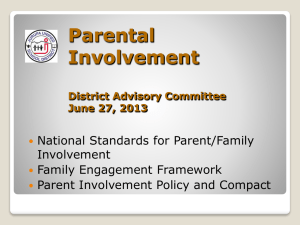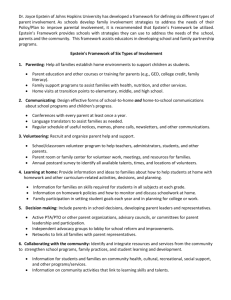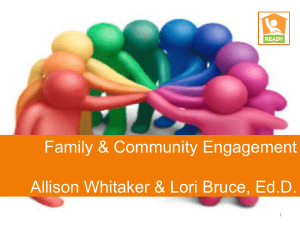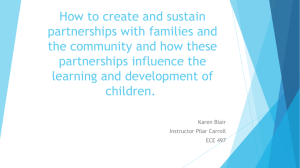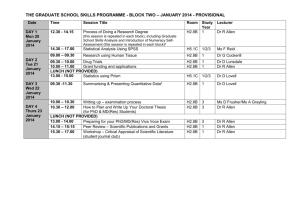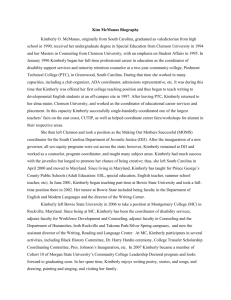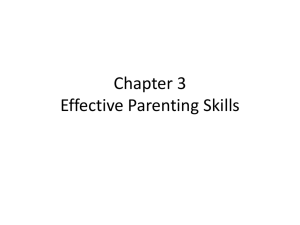Home/school connection: Helping Families support their children`s
advertisement
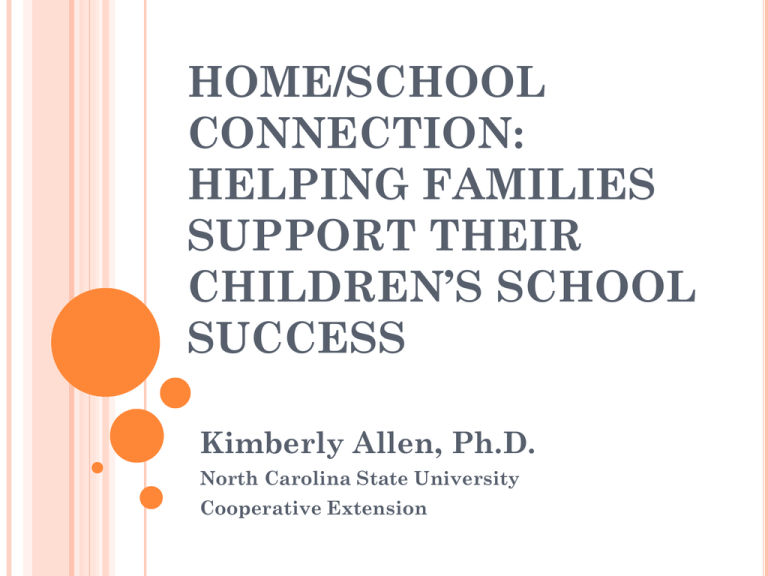
HOME/SCHOOL CONNECTION: HELPING FAMILIES SUPPORT THEIR CHILDREN’S SCHOOL SUCCESS Kimberly Allen, Ph.D. North Carolina State University Cooperative Extension TODAY’S TALK Where we have been Where we are Benefits of home/school connection Barriers to family involvement How to reach families Life ain’t like what it used to be! What happened? MY HOW THINGS HAVE CHANGED… In small groups, answer these questions: How have families changed? How has education changed? What about community change? What do you know about the role of parents in the educational process? WHAT WAS SCHOOL LIKE WHEN YOU WERE YOUNG? Subjects Taught? Norms and practices? Out of school activities? COMPARE THAT WITH TODAY’S EDUCATIONAL PROCESS 21ST CENTURY LEARNING THE TRANSITION FROM MAKING THINGS TO KNOWING THINGS HOW INVOLVED WERE YOUR PARENTS IN YOUR EDUCATION? HOW INVOLVED ARE TODAY’S PARENTS? A WORLD OF DISCONNECTS Disconnections Little mealtime and playtime together Techno-interference Disconnects at the Family level at the School level Student engagement Class size, Accountability standards Disconnects at the Community level Transience, knowing your neighbor? Economic survival Community involvement, mentors, role models DID YOU KNOW 1 in 3 students who start high school in North Carolina does not graduate. Less than 60% of our African American students and 52% of Hispanic students graduate. ~ Action for Children, 2008 IT CAN GET BETTER IF WE Build on individual, family and community strengths Help parents actively engage in their child’s education Create a comprehensive education that provides skill training AND connects with pupil’s stakeholders Community Policies supporting developmental and risk-level tailored interventions Neighborhood attachment and organization Family and peers Family cohesion Individual Family involvement Laws and norms Relationships between systems Student-teacher relationships, supportive youth-adult relationships (e.g. 4-H) Temperament, age, developmental level, intelligence, perceived academic competency Peer risky behaviors Schools and supportive agencies CRITICAL ELEMENTS IN OUTREACH FOR SUSTAINABLE PARENT INVOLVEMENT Family involvement Active teacher outreach Parent involvement School-family partnerships HOME/SCHOOL CONNECTION HELPS CHILDREN Earn higher grades and test scores Be promoted, pass their classes, and earn credits Attend school regularly Have better social skills and improved behavior Graduate and go on to postsecondary school AND… Family participation in education is twice as predictive of students’ academic success as family socioeconomic status. Some of the more intensive programs had effects that were 10 times greater than other factors In fact, the more involvement, the better (Walberg, 1984) MAJOR FACTORS OF PARENT INVOLVEMENT 1. Parents’ beliefs about what is important, necessary and permissible 2. The extent to which parents believe that they can have a positive influence on their children’s education 3. Parents’ perceptions that their children and school want them to be involved WHY AREN’T PARENTS MORE INVOLVED? BARRIERS TO PARENTAL INVOLVEMENT Time Knowledge School policies Negative Past Experiences Lack of Communication Lack of Training Language/Literacy Barriers Faced By Parents Credit to Behnke, A., North Carolina State University Unfamiliar and intimidating systems Attitudes of Personnel Life factors Past Educational Experiences Work schedules Child care Transportation Lack of Information ACTIVITY: Take 5 minutes and discuss this question with your neighbor: What do parents need in order to better connect with their child’s school? What can we do to help the parents we serve? WORKING WITH PARENTS IS HOW YOU CAN HELP! ECA members can help parents actively engaged in their education by Educating parents on the benefits of parent/school connection and Helping parents develop skills & strategies for being more involved. SIX TYPES OF FAMILY INVOLVEMENT PARENTING COMMUNICATING VOLUNTEERING LEARNING AT HOME DECISION MAKING COLLABORATING WITH THE COMMUNITY • (EPSTEIN, 1997) RESEARCH ON PARENTING ATTITUDES AND ACTIONS Quality of parent–youth relationships matters—the more connected a child feels to their parent, the better chance of school success Monitoring youth behaviors positively influences adolescent achievement A parent attending school functions tends to yield higher academic success PARENT/SCHOOL COMMUNICATION On-going, two-way communication with school and parents: Builds positive relationships between children and their teachers, Leads to greater parent involvement, Promotes school readiness. HELP PARENTS KNOW HOW TO COMMUNICATE WITH SCHOOLS 1. Parent/teacher conference 2. Call/e-mail/text 3. Schedule a meeting 4. Volunteer 5. Lunch with student DID YOU KNOW When adolescents perceive that their parents have high educational goals for them, they: have more interest in school, greater academic self-regulation, higher motivation and goal pursuits VOLUNTEERING In or out of school volunteering fosters educational success Encourage parents to find a way to contribute to school Three for Me: Three hours of volunteer time each year A PTA program that helps parents find different ways to volunteer in the home, in the school and in the community, all of which support student learning. LET PARENTS KNOW HOW TO HELP FROM HOME Send positive messages about school Discuss their classroom activities Listening carefully to their explanations of what has been learned PARENTS CAN HELP WITH Reading at home Reinforcing classroom concepts Providing time and a place for doing homework Encouraging their children to keep trying when the work becomes difficult Monitoring homework completion Turning off the TV Engaging with their children in educational activities such as field trips, games and activities DECISION MAKING Include families as partners in school decisions, governance, and advocacy through PTA/PTO, school councils, committees, and other parent organizations. WHAT CAN PARENT’S DO? Visit classes Encourage attendance Monitoring Children Advocate for their child Participate in parent-teacher conferences COMMUNITY COLLABORATION Coordinate resources and services for families, students, and the school with businesses, agencies, and other groups, and provide services to the community. PARENTS CAN Work with YOU about how to help their child succeed Work to inform family-friendly policies at the classroom, school or district levels Network with other children, parents, teachers and administrators PARENT INVOLVEMENT ISN’T THE ANSWER School, family, and community partnerships can replace the term “parental involvement” Parents, educators, and community members must share responsibility for students’ learning and development. IF WE BUILD IT, WILL THEY COME? Early Childhood is a great place to start. Early Childcare Centers in your community Head Start/Early Head Start in every county Parents as Teachers Local school districts Faith-based organizations After school organizations Youth-serving groups COMMUNITY DEVELOPMENT IS ABOUT BUILDING RELATIONSHIPS Do you have relationships with centers or agencies that focus on children’s education? If not, you will need to develop a relationship. How would you do that? EASY AS 1, 2, 3. Write down 1 center or agency you will target to implement this program in your community Write down 2 dates that you will visit the agency or center. List 3 people that you will call on for assistance and follow through with this program. YOU CAN MAKE A DIFFERENCE. YOU DO MAKE A DIFFERENCE EVERY DAY Thank you for all you have done for children and families in North Carolina! Do call if I can be of assistance! Kimberly Allen, PhD Assistant Professor and Extension Specialist 4-H Youth Development & Family and Consumer Sciences (919) 515-9139 kimberly_allen@ncsu.edu REFERENCES Arnold, D.H., Zeljo, A., Doctoroff, G. L., & Ortiz, C. (2008). Parent involvement in preschool: Predictors and the relation of involvement to preliteracy development. School Psychology Review, 37(1), 74-90. Bouffard, S. (2008). Tapping into technology: The role of the Internet in family-school communication. Retrieved May 19, 2010, from http://www.hfrp.org/family involvement/publications-resources/tapping-into-technology-the-role-of-the-internetin-family-school-communication. Epstein & Sheldon (2006). Moving Forward: Ideas for Research on School, Family, and Community Partnerships in C. F. Conrad & R. Serlin (Eds.) SAGE Handbook for research in education: Engaging ideas and enriching inquiry. Thousand Oaks, CA: Sage Publications. Epstein, J. L. (1987). Toward a theory of family–school connections: Teacher practices and parent involvement. In K. Hurrelman, F. X. Kaufman, & F. Losel (Eds.), Social intervention: Potential and con- straints (pp. 121–136). Berlin, Germany: de Gruyer. Hill, N. E. (2001). Parenting and academic socialization as they relate to school readiness: The role of ethnicity and family income. Journal of Educational Psychology, 93, 686–697. Shumow, L. & Miller, J.D. (2001). Parents’ at-home and at-school academic involvement with young adolescents. Journal of Early Adolescence, 21, 68-91. Walberg (1984). Review of 29 students of school-parent programs
